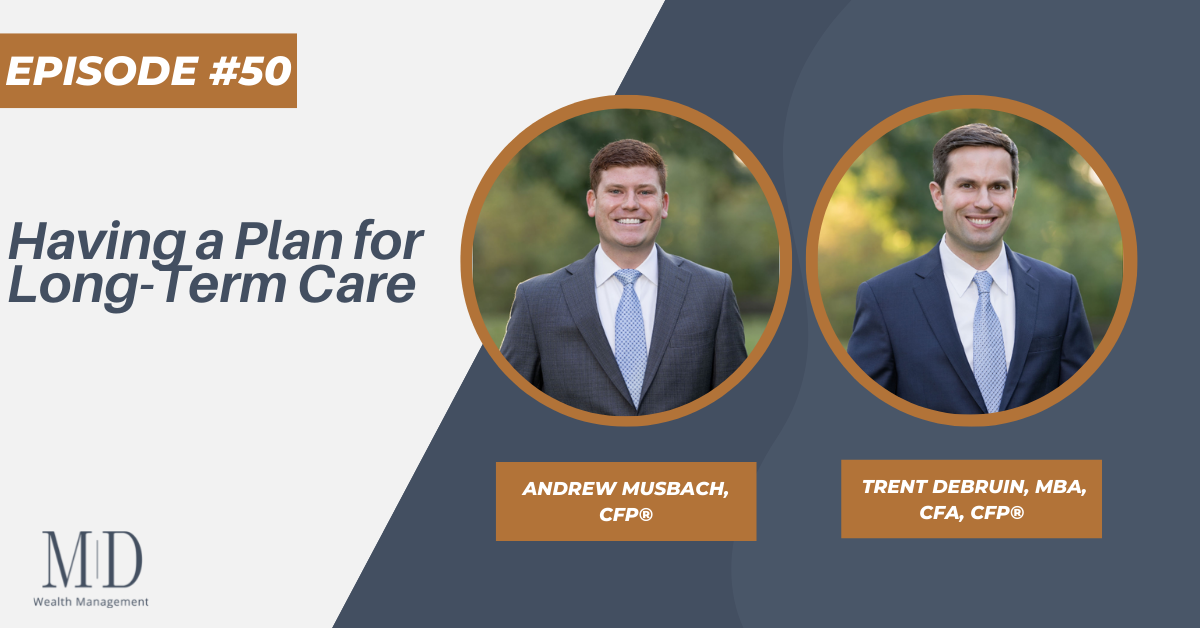
Having a Plan for Long-Term Care, Episode #50
While it’s not the most exciting topic to discuss, long-term care is an important one given how common long-term care events are and their ability to impact a retirement plan due to their potential cost. In this episode, we start out by providing some background and overview of long-term care and some of the numbers around frequency and cost. Based on that, we explain why it’s important to have a plan for how to protect against long-term care risks. We then wrap things up by talking about the different options for how to actually protect against this risk (which at a basic level is either buying insurance, self-insuring, or some combination of the two) and discuss some of the pros and cons of each option. Our goal is for you to come away with a good understanding of this planning area and which approach to protecting against long-term care risk is right for you based on the specifics of your unique situation.
Outline of this episode
- What are long-term care services and who will need them? [1:49]
- Self-funding long-term care services and understanding the costs [4:58]
- Protecting against long-term care risks with insurance [11:27]
- Hybrid long-term care insurance policies [13:41]
- Pros and cons of the different long-term care insurances [15:33]
- The recap [21:44]
What is long-term care insurance and who needs it?
Long-term care services involve someone helping you with the basic activities of living if you're unable to do them on your own because of illness or old age. These include things like eating, bathing, dressing, moving around, etc. Long-term care services can be provided at home, in a long-term care facility, or by friends or family. It's an extremely common occurrence as people age, and just to put some numbers to it, approximately 70% of people turning age 65 today will need some form of long-term care services during their lifetime and 20% of those people will need care for two years or more.
Most of us are likely to experience some type of long-term care event during our lifetimes, which isn't covered by insurance. For most people, the cost is likely to be small but for a minority of people, the cost can be quite large to the extent that it could potentially impact your retirement plan. Due to this, everyone should have a plan for long-term care, whether that's self-funding, buying insurance, or some combination of the two.
Planning for self-funding long-term care needs
The first step in putting together your plan is figuring out whether or not you can self-fund. You can afford to self-fund if you can pay for a potential long-term care stay from the assets you've accumulated for retirement without it impacting your retirement plan. Unfortunately, there isn't a black and white formula for determining whether you can self-fund, but we’ll walk you through a process to follow to figure it out.
Step one is determining the probability and timing for potentially needing long-term care. This is going to be different for everyone. Step two is then understanding the cost of a long-term care event. We sometimes talk about long-term care as a fixed service, but there are different types and the cost varies depending on which option you choose.
The third step is estimating the cost of a long-term care stay for you based on your situation. You might prefer in-home care to a private nursing home, which is much cheaper and would reduce your potential costs. There are situations where people have friends or family (most often children) who would be willing and able to provide long-term care if needed. In those situations, your estimated costs would potentially be zero. But whatever your situation and preferences, step three is about realistically estimating what your personal, or household (if you’re married), long-term care expenses would be. Step four is when you take that estimate for what your household's long-term care expenses could or would be and plug it into your retirement projections to see whether your current retirement plan can absorb a long-term care event.
When and what
If you can't self-insure and you aren't comfortable bearing the long-term care risk, insurance might be a good alternative. There are some pros, cons, and pitfalls to avoid that we talk about in the episode. The big question is when to get the insurance and what kind to purchase.
Unfortunately, there's no perfect age for buying long-term care insurance in terms of getting a "good deal" on it. Long-term care insurance is similar to life insurance where you get a better price if you buy it when you're younger and healthier, but that also means paying premiums for longer. A good ballpark of when to consider purchasing long-term care insurance is between age 55 and 60 for the best combination of coverage and affordability. It will cost more for women because they tend to live longer.
When it comes to long-term care insurance, there are two basic types. A traditional standalone policy and something called a hybrid policy, and we walk through each type in more detail in the episode.
Resources & People Mentioned
- Download our guide: Retirement Timeline – Key Dates & Opportunities
- Download our guide: Retirement Checklist – A Guide to Planning for Retirement
- Genworth long-term care cost calculator
Connect With Trent and Andrew
- https://mdwmllc.com
- Follow on LinkedIn
- Follow on Facebook
Subscribe to The Physician’s Guide To Financial Wellness
on Apple Podcast, Spotify, and Google Podcast

